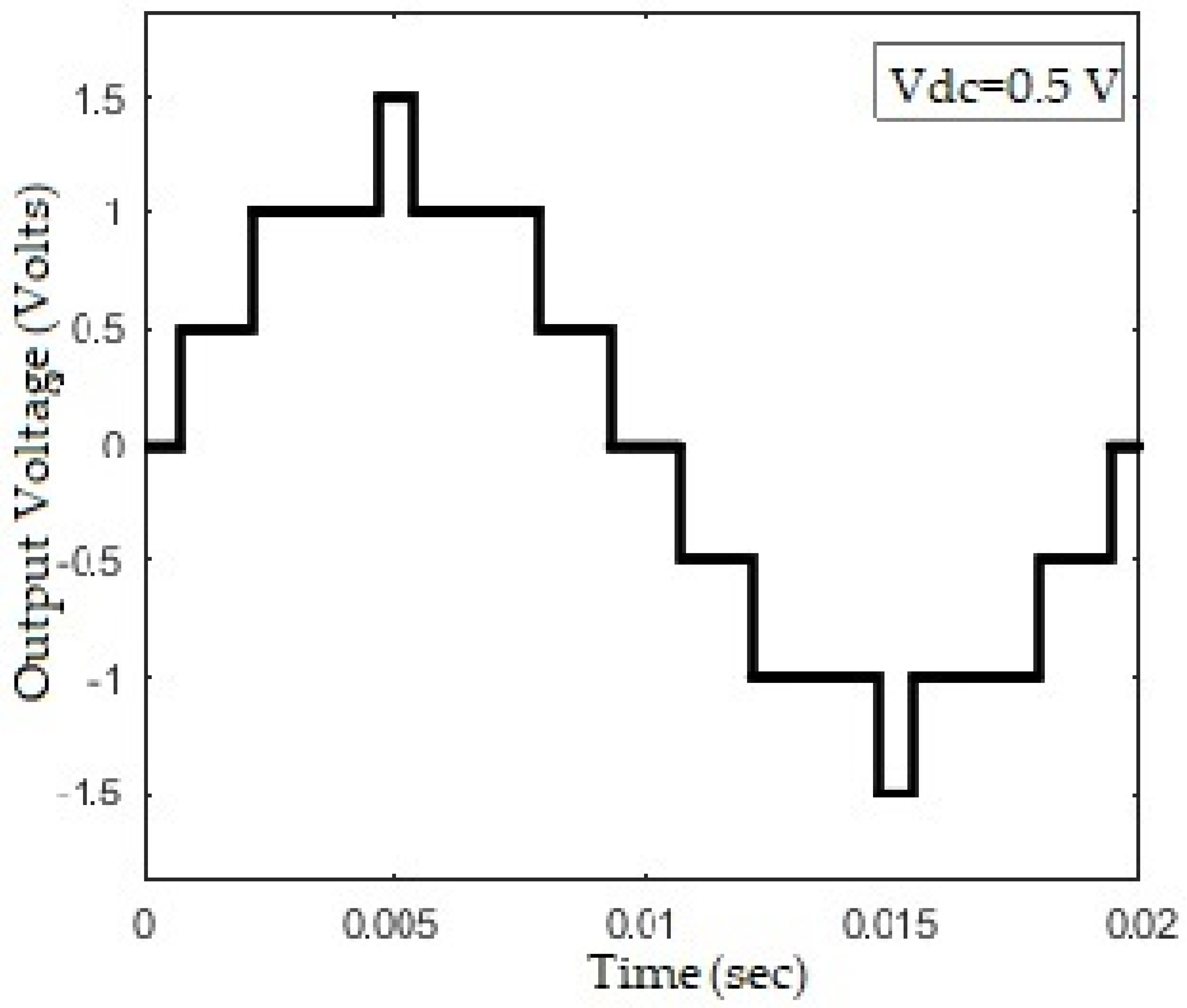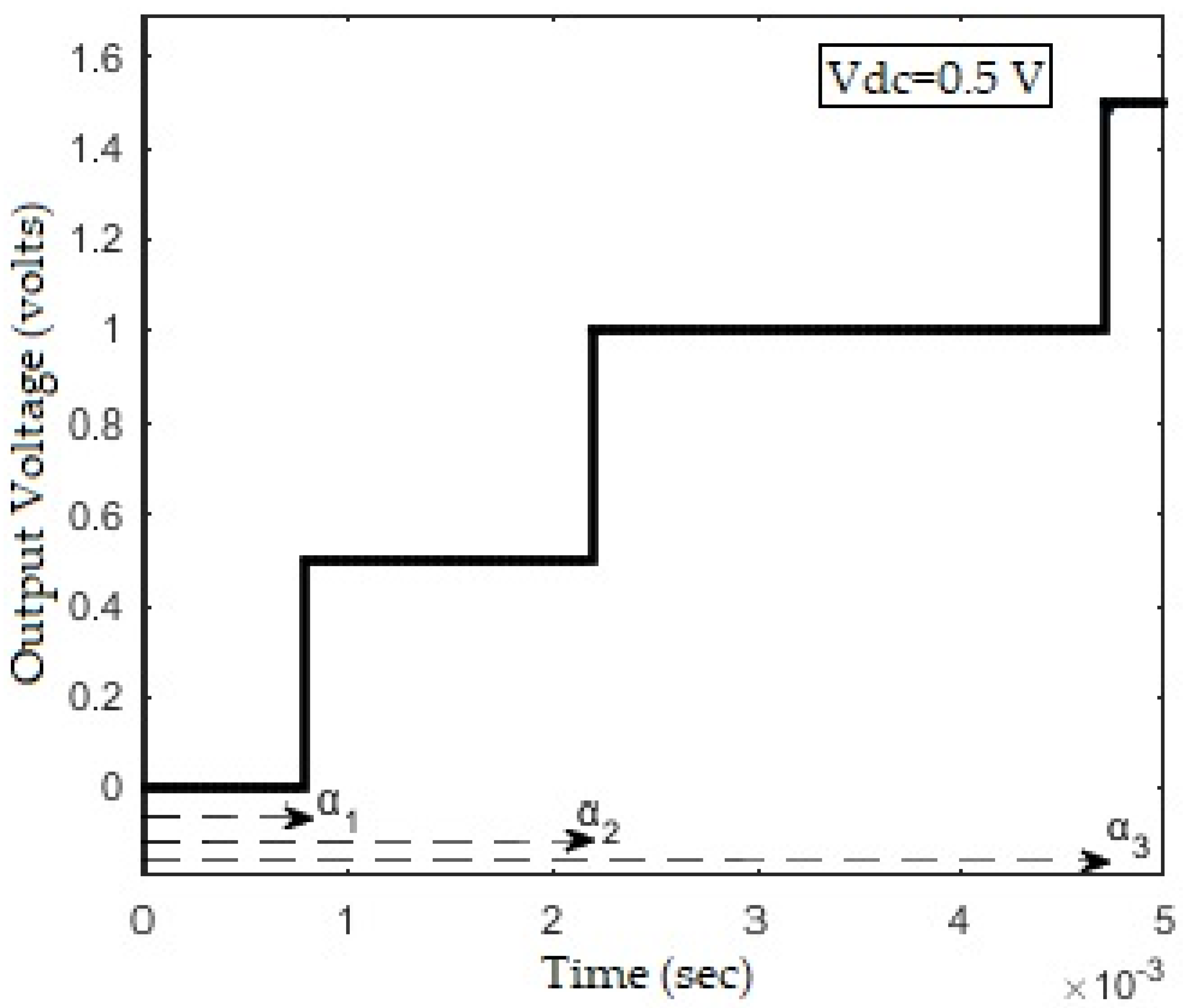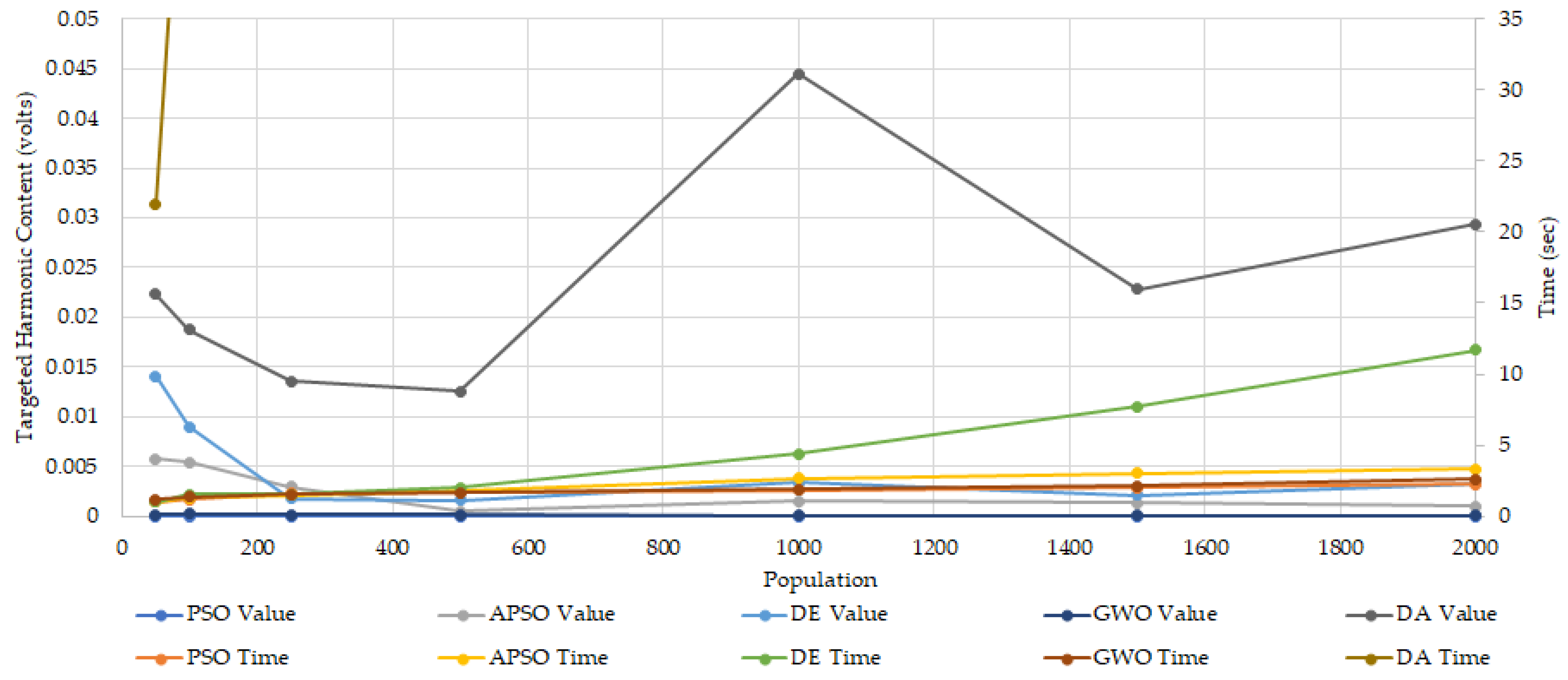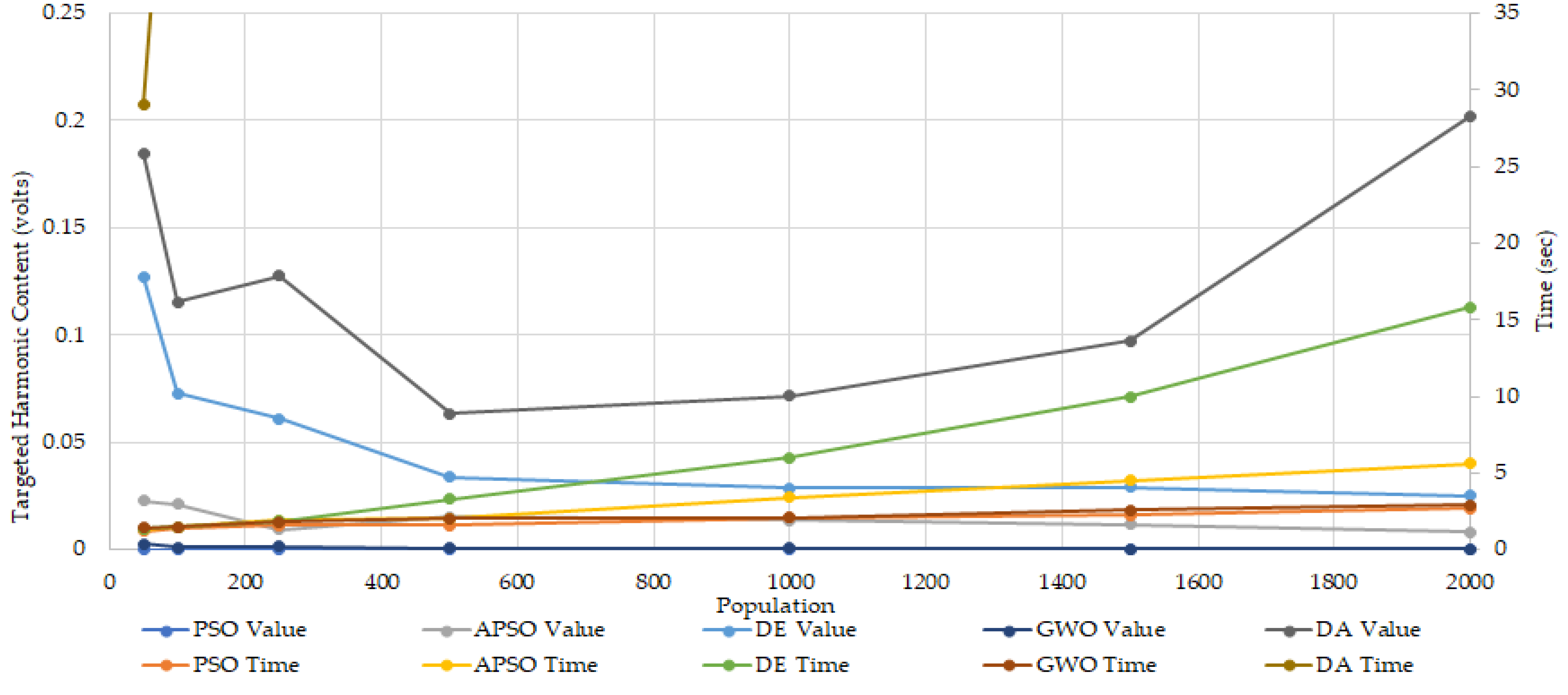Dragonfly Algorithm-Based Optimization for Selective Harmonics Elimination in Cascaded H-Bridge Multilevel Inverters with Statistical Comparison
Abstract
:1. Introduction
2. Selective Harmonics Elimination Problem
3. Methodology
3.1. Particle Swarm Optimization
- Initialize positions and velocities for each particle.
- Find the personally fittest and globally fittest particles.
- Set the termination criterion.
- Start the iterations.
- Deploy Equations (10) and (11) to get new positions of each particle.
- Repeat the second step and jump to the fifth step.
- Repeat the sixth step until termination is reached.
- Consider the globally fittest position as the answer.
3.2. Accelerated Particle Swarm Optimization
- Initialize the position for each particle and set the parameter values.
- Find the fitness function value for each particle.
- Find the globally fittest particle.
- Update the position of each particle by using Equation (12).
- Repeat the above three steps till the stopping criterion is reached.
- Note down the position of the globally fittest particle.
3.3. Differential Evolution Algorithm
- Initialize the population randomly.
- Set the differential weight and cross-over parameters to desired values.
- Start the iterative process.
- According to the defined procedure for the current iteration, choose the vectors and .
- Deploy Equation (13) to perform mutation.
- Perform cross-over procedure.
- Perform the selection process.
- Repeat the four steps above until the stopping criterion is met.
- Note down the fittest vector after the whole process.
3.4. Grey Wolf Optimization
- Initialize the population of grey wolves randomly.
- Initialize the values of involved constants , and .
- Calculate alpha, beta, and gamma wolves (the top three best value positions).
- Start the iterations.
- Calculate the prey’s position with the aid of alpha, beta, and gamma wolves (the top three best value positions at the current iteration).
- Use Equations (14) and (15) to update the position of each grey wolf.
- Update the constants involved.
- Update alpha, beta, and gamma wolves’ positions.
- Repeat the four steps above until the stopping criterion is met.
- Note down the best vector after the whole process.
3.5. Dragonfly Algorithm
- Assign random locations to the dragonflies and find the fitness. Assign values to food and enemy.
- Decide the stopping criterion and start iterations.
- Update the weights based on iteration number and randomness.
- In the presence of a neighbor, calculate ‘’, ‘’, ‘’, ‘’, and ‘’ for each fly. Update the position by adding the current position in Equation (18).
- In the absence of a neighbor, assign a new position to dragonfly using a random walk.
- Perform the third step and then the fourth or fifth step depending on the neighbor’s presence after updating food and enemy.
- Repeat the above step till termination is reached.
- Note down the food position.

4. Results and Discussion
4.1. Implementation of Seven Level Inverter
4.2. Implementation of Nine Level Inverter
4.3. Implementation of Eleven Level Inverter
4.4. Statistical Comparison
4.5. Discussion
5. Conclusions
Author Contributions
Funding
Data Availability Statement
Acknowledgments
Conflicts of Interest
References
- Tamilvani, P.; Valluvan, K.R. Harmonic Mitigation in Various Levels of Multilevel Inverter with Different Loads. Int. J. Innov. Res. Electr. Electron. Instrum. Control. Eng. 2014, 2, 1989–1996. [Google Scholar]
- Bughneda, A.; Salem, M.; Richelli, A.; Ishak, D.; Alatai, S. Review of Multilevel Inverters for PV Energy System Applications. Energies 2021, 14, 1585. [Google Scholar] [CrossRef]
- Malinowski, M.; Gopakumar, K.; Rodriguez, J.; Peres, M.A. A Survey on Cascaded Multilevel Inverters. IEEE Trans. Ind. Electron. 2010, 57, 2197–2206. [Google Scholar] [CrossRef]
- Kouro, S.; Malinowski, M.; Gopakumar, K.; Pou, J.; Franquelo, L.G.; Wu, B.; Rodriguez, J.; Peres, M.A.; Leon, J.I. Recent Advances and Industrial Applications of Multilevel Converters. IEEE Trans. Ind. Electron. 2010, 57, 2553–2580. [Google Scholar] [CrossRef]
- Konstantinou, G.S.; Dahidah, M.S.A.; Agelidis, V.G. Solution trajectories for selective harmonic elimination pulse-width modulation for seven level waveforms: Analysis and implementation. IET Power Electron. 2012, 5, 22–30. [Google Scholar] [CrossRef]
- Fei, W.; Ruan, X.; Wu, B. A Generalized Formulation of Quarter-Wave Symmetry SHE-PWM Problems for Multilevel Inverters. IEEE Trans. Power Electron. 2009, 24, 1758–1765. [Google Scholar] [CrossRef]
- Fei, W.; Du, X.; Wu, B. A Generalized Half-Wave Symmetry SHE-PWM Formulation for Multilevel Voltage Inverters. IEEE Trans. Ind. Electron. 2010, 57, 3030–3038. [Google Scholar]
- Hagh, M.T.; Taghizadeh, H.; Razi, K. Harmonic Minimization in Multilevel Inverters Using Modified Species-Based Particle Swarm Optimization. IEEE Trans. Power Electron. 2009, 24, 2259–2267. [Google Scholar] [CrossRef]
- Al-Hitmi, M.; Ahmad, S.; Iqbal, A.; Padmanaban, S.; Ashraf, I. Selective Harmonics Elimination in a Wide Modulation Range Using Modified Newton—Raphson and Pattern Generation Methods for a Multilevel Inverter. Energies 2018, 11, 458. [Google Scholar] [CrossRef]
- Yang, X.S. Introduction to Mathematical Optimization: From Linear Programming to Metaheuristics, 1st ed.; Cambridge International Science Publishing: Cambridge, UK, 2008; pp. 107–118. [Google Scholar]
- Ismail, B.; Hassan, S.I.S.; Ismail, R.C.; Haron, A.R.; Azmi, A. Selective Harmonic Elimination of Five-Level Cascaded Inverter Using Particle Swarm Optimization. Int. J. Engg. Tech. 2013, 5, 5220–5232. [Google Scholar]
- Maharana, M.K. PSO based Harmonic Reduction Technique for Wind Generated Power System. Int. J. Power Syst. Oper. Energy Manag. 2013, 2, 31–35. [Google Scholar] [CrossRef]
- Janjamraj, N.; Oonsivilai, A. Harmonic Elimination of Hybrid Multilevel inverters Using Particle Swarm Optimization. World Acad. Sci. Engg. Tech. Int. J. Electr. Comput. Energ. Electron. Comm. Engg. 2012, 6, 1461–1466. [Google Scholar]
- Madichetty, S.; Rambabu, M.; Dasgupta, A. Selective harmonic elimination: Comparative analysis by different optimization methods. In Proceedings of the IEEE 6th India International Conference on Power Electronics, Kurukshetra, India, 8–10 December 2014; pp. 1–6. [Google Scholar]
- Vijayakumar, R.; Devalalitha, C.; Nachiappan, A.; Mazhuvendhi, R. Selective harmonic elimination PWM method using two level inverter by differential evolution optimization technique. In Proceedings of the 2014 International Conference on Science Engineering and Management Research, Chennai, India, 27–29 November 2014; pp. 1–6. [Google Scholar]
- Routray, A.; Singh, R.K.; Mahanty, R. Harmonic Reduction in Hybrid Cascaded Multilevel Inverter Using Modified Grey Wolf Optimization. IEEE Trans. Ind. App. 2020, 56, 1827–1838. [Google Scholar] [CrossRef]
- Espinosa, C.A.L.; Portocarrero, I.; Izquierdo, M. Minimization of THD and angles calculation for multilevel inverters. Int. J. Engg. Tech. 2012, 12, 83–86. [Google Scholar]
- Amin, A.A.; Patel, R.K.; Vasavada, M.R. Optimal Placement and Sizing of Distributed Generation in Distributed Power System using Dragonfly Algorithm. Int. J. Innov. Res. Electr. Electron. Instr. Contr. Engg. 2017, 5, 197–203. [Google Scholar] [CrossRef]
- Bashishtha, T.K. Nature Inspired Meta-heuristic dragonfly Algorithms for Solving Optimal Power Flow Problem. Int. J. Electron. Electr. Comput. Syst. 2016, 5, 111–120. [Google Scholar]
- Asli, B.Z.; Haddad, O.B.; Chu, X. Dragonfly Algorithm (DA). In Advanced Optimization by Nature-Inspired Algorithms, 1st ed.; Haddad, O.B., Ed.; Springer: Singapore, 2018; Volume 720, pp. 151–159. [Google Scholar]
- Fakhar, M.S.; Kashif, S.A.R.; Liaquat, S.; Rasool, A.; Padmanaban, S.; Iqbal, M.A.; Baig, M.A.; Khan, B. Implementation of APSO and Improved APSO on Non-Cascaded and Cascaded Short Term Hydrothermal Scheduling. IEEE Access 2021, 9, 77784–77797. [Google Scholar] [CrossRef]
- Yang, X.S. Nature-Inspired Optimization Algorithms, 2nd ed.; Elsevier: Cambridge, MA, USA, 2020; pp. 101–109. [Google Scholar]
- Rezaei, H.; Haddad, O.B.; Chu, X. Grey Wolf Optimization (GWO) Algorithm. In Advanced Optimization by Nature-Inspired Algorithms, 1st ed.; Haddad, O.B., Ed.; Springer: Singapore, 2018; Volume 720, pp. 81–91. [Google Scholar]
- Jamil, M.; Zepernick, H.J. Levy Flights and Global Optimization. In Swarm Intelligence and Bio-Inspired Computation: Theory and Applications; Yang, X.S., Cui, Z., Xiao, R., Gandomi, A.H., Karamanoglu, M., Eds.; Elsevier: London, UK, 2013; pp. 49–72. [Google Scholar]
- Kerr, A.W.; Hall, H.K.; Kozub, S.A. Doing Statistics with SPSS, 1st ed.; Sage Publications Ltd.: London, UK, 2002; pp. 114–122. [Google Scholar]
- Yang, X.S. Engineering Optimization: An Introduction with Metaheuristic Applications, 1st ed.; Wiley: Hoboken, USA, 2010; pp. 25–27. [Google Scholar]











| Algorithm | α1 (rad) | α2 (rad) | α3 (rad) | Time (s) | Best Result (V) | Population |
|---|---|---|---|---|---|---|
| PSO | 0.2305 | 0.6640 | 1.4476 | 1 | 3.89 × 10−16 | 50 |
| APSO | 0.2305 | 0.6641 | 1.4476 | 1.8 | 5.26 × 10−4 | 500 |
| DE | 0.2309 | 0.6635 | 1.4471 | 2 | 1.565 × 10−3 | 500 |
| GWO | 0.2305 | 0.6640 | 1.4475 | 1.9 | 6.113 × 10−5 | 1000 |
| DA | 0.2335 | 0.6592 | 1.4430 | 610 | 1.257 × 10−2 | 500 |
| Algorithm | Particle Swarm Optimization (PSO) | Accelerated Particle Swarm Optimization (APSO) | Differential Evolution (DE) | Grey Wolf Optimization (GWO) | Dragonfly Algorithm (DA) |
|---|---|---|---|---|---|
| 3rd Harmonic | 0.19% | 0.19% | 0.19% | 0.19% | 0.18% |
| 5th Harmonic | 0.07% | 0.07% | 0.07% | 0.07% | 0.47% |
| Algorithm | PSO | APSO | DE | GWO | DA |
|---|---|---|---|---|---|
| 3rd Harmonic | 0.44% | 0.66% | 0.11% | 0.44% | 0.24% |
| 5th Harmonic | 0.36% | 0.26% | 0.14% | 0.36% | 0.27% |
| 7th Harmonic | 0.47% | 0.06% | 0.14% | 0.47% | 0.18% |
| Algorithm | α1 (rad) | α2 (rad) | α3 (rad) | α4 (rad) | Time (s) | Best Result (V) | Population |
|---|---|---|---|---|---|---|---|
| PSO | 0.1892 | 0.4600 | 0.9260 | 1.5380 | 1.6 | 6.25 × 10−16 | 500 |
| APSO | 0.1895 | 0.4604 | 0.9281 | 1.5394 | 5.6 | 8.23 × 10−3 | 2000 |
| DE | 0.1857 | 0.4649 | 0.9224 | 1.5335 | 15.8 | 2.51 × 10−2 | 2000 |
| GWO | 0.1891 | 0.4600 | 0.9259 | 1.5379 | 2.9 | 4.14 × 10−4 | 2000 |
| DA | 0.1925 | 0.4638 | 0.9429 | 1.5483 | 647 | 6.32 × 10−2 | 500 |
| Algorithm | PSO | APSO | DE | GWO | DA |
|---|---|---|---|---|---|
| 3rd Harmonic | 0.08% | 0.12% | 0.11% | 0.08% | 0.3% |
| 5th Harmonic | 0.2% | 0.23% | 0.15% | 0.21% | 0.36% |
| 7th Harmonic | 0.31% | 0.3% | 0.38% | 0.3% | 0.41% |
| 9th Harmonic | 0.08% | 0.15% | 0.00% | 0.08% | 0.31% |
| Algorithm | α1 (rad) | α2 (rad) | α3 (rad) | α4 (rad) | α5 (rad) | Time (s) | Best Result (V) | Population |
|---|---|---|---|---|---|---|---|---|
| PSO | 0.0150 | 0.4338 | 0.6133 | 1.0620 | 1.5707 | 1.86 | 7.225 × 10−2 | 250 |
| APSO | 0.0064 | 0.4340 | 0.6120 | 1.0614 | 1.5707 | 6.9 | 7.81 × 10−2 | 2000 |
| DE | 0.0305 | 0.4312 | 0.6152 | 1.0615 | 1.5707 | 12.5 | 1.07 × 10−1 | 1500 |
| GWO | 0.0158 | 0.4338 | 0.6135 | 1.0620 | 1.5707 | 3 | 7.328 × 10−2 | 1500 |
| DA | 0.00 | 0.4349 | 0.6127 | 1.0628 | 1.5707 | 865 | 9.085 × 10−2 | 500 |
| Inverter | Generation | Best Average Ranking | ||||
|---|---|---|---|---|---|---|
| PSO | APSO | DE | GWO | DA | ||
| 7 Levels | 50 | 1st | 1st/2nd | 4th | 2nd/3rd | 3rd |
| 100 | 1st | 1st | 3rd | 1st | 2nd | |
| 250 | 1st | 1st/2nd | 4th | 2nd | 3rd | |
| 500 | 1st | 1st | 3rd | 1st | 2nd | |
| 1000 | 1st | 1st | 3rd | 1st | 2nd | |
| 1500 | 1st | 1st | 3rd | 1st | 2nd | |
| 2000 | 1st | 1st | 3rd | 1st | 2nd | |
| 9 Levels | 50 | 2nd | 2nd | 3rd | 1st | 2nd |
| 100 | 2nd/3rd | 1st/2nd | 4th | 1st | 3rd | |
| 250 | 1st | 1st | 3rd | 1st | 2nd | |
| 500 | 1st | 1st | 3rd | 1st | 2nd | |
| 1000 | 1st | 1st | 3rd | 1st | 2nd | |
| 1500 | 1st | 1st/2nd | 4th | 2nd | 3rd | |
| 2000 | 1st | 1st | 3rd | 2nd | 3rd | |
| 11 Levels | 50 | 2nd | 2nd | 3rd | 1st | 2nd |
| 100 | 3rd | 2nd | 4th | 1st | 2nd/3rd | |
| 250 | 2nd | 2nd | 3rd | 1st | 2nd | |
| 500 | 2nd | 2nd | 3rd | 1st | 2nd | |
| 1000 | 2nd | 2nd | 4th | 1st | 3rd | |
| 1500 | 2nd | 2nd | 4th | 1st | 3rd | |
| 2000 | 2nd | 2nd | 3rd | 1st | 2nd | |
Publisher’s Note: MDPI stays neutral with regard to jurisdictional claims in published maps and institutional affiliations. |
© 2022 by the authors. Licensee MDPI, Basel, Switzerland. This article is an open access article distributed under the terms and conditions of the Creative Commons Attribution (CC BY) license (https://creativecommons.org/licenses/by/4.0/).
Share and Cite
Tariq, M.A.; Shami, U.T.; Fakhar, M.S.; Kashif, S.A.R.; Abbas, G.; Ullah, N.; Mohammad, A.; Farrag, M.E. Dragonfly Algorithm-Based Optimization for Selective Harmonics Elimination in Cascaded H-Bridge Multilevel Inverters with Statistical Comparison. Energies 2022, 15, 6826. https://doi.org/10.3390/en15186826
Tariq MA, Shami UT, Fakhar MS, Kashif SAR, Abbas G, Ullah N, Mohammad A, Farrag ME. Dragonfly Algorithm-Based Optimization for Selective Harmonics Elimination in Cascaded H-Bridge Multilevel Inverters with Statistical Comparison. Energies. 2022; 15(18):6826. https://doi.org/10.3390/en15186826
Chicago/Turabian StyleTariq, Muhammad Ayyaz, Umar Tabrez Shami, Muhammad Salman Fakhar, Syed Abdul Rahman Kashif, Ghulam Abbas, Nasim Ullah, Alsharef Mohammad, and Mohamed Emad Farrag. 2022. "Dragonfly Algorithm-Based Optimization for Selective Harmonics Elimination in Cascaded H-Bridge Multilevel Inverters with Statistical Comparison" Energies 15, no. 18: 6826. https://doi.org/10.3390/en15186826
APA StyleTariq, M. A., Shami, U. T., Fakhar, M. S., Kashif, S. A. R., Abbas, G., Ullah, N., Mohammad, A., & Farrag, M. E. (2022). Dragonfly Algorithm-Based Optimization for Selective Harmonics Elimination in Cascaded H-Bridge Multilevel Inverters with Statistical Comparison. Energies, 15(18), 6826. https://doi.org/10.3390/en15186826









